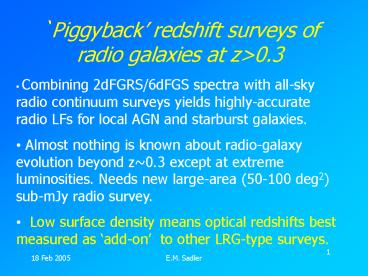Piggyback redshift surveys of radio galaxies at z0'3 - PowerPoint PPT Presentation
1 / 14
Title:
Piggyback redshift surveys of radio galaxies at z0'3
Description:
`Piggyback' redshift surveys of radio galaxies at z 0.3 ... Needs new large-area (50-100 deg2) sub-mJy radio survey. ... the local radio-source population is ... – PowerPoint PPT presentation
Number of Views:20
Avg rating:3.0/5.0
Title: Piggyback redshift surveys of radio galaxies at z0'3
1
Piggyback redshift surveys of radio galaxies at
zgt0.3
- Combining 2dFGRS/6dFGS spectra with all-sky
radio continuum surveys yields highly-accurate
radio LFs for local AGN and starburst galaxies. - Almost nothing is known about radio-galaxy
evolution beyond z0.3 except at extreme
luminosities. Needs new large-area (50-100 deg2)
sub-mJy radio survey. - Low surface density means optical redshifts
best measured as add-on to other LRG-type
surveys.
2
Previous add-on radio surveys
1) 2dFGRS NVSS (main survey only) 1.5 radio
det. rate, 3200 objects to 2.5 mJy, zlt0.3 2)
6dFGS NVSS/SUMSS (main surveyadd. targets) 16
radio det. rate, DR1 4145 objects to 2.5 mJy 3)
SDSS/2dF LRG FIRST (main survey only) 3 radio
det. rate, 210 objects to 0.8 mJy (0.5ltzlt0.7)
3
2dFGRS radio emission from starburst galaxies
UGC 09057 NGC
5257/5258 NGC 7252
z0.0054
z0.0223
z0.0161 Derived SFR 1.8 Msun/yr 120
Msun/yr 32 Msun/yr
(Radio emission is dominated by synchrotron
radiation from electrons accelerated by supernova
remnants)
4
2dFGRS Radio emission from AGN
TGN284Z051 TGN348Z183
TGS153Z214 z0.1065
z0.1790
z0.2079 1.4 GHz radio power and
projected linear size
1024.3 W/Hz
1025.0 W/Hz 1024.8 W/Hz
327 kpc 475 kpc
471 kpc
5
Typical 2dFGRS radio-source spectra
- Star-forming galaxy, z 0.14 (40)
Starburst - Emission-line AGN, z 0.15 (10) Seyfert
- Absorption-line AGN, z 0.14 (50) Radio galaxy
Ha
Hb
OIII
(Sadler et al. 1999)
6
2dFGRS Local radio LFs for active and
star-forming galaxies
Below 1025 W/Hz, the local radio-source
population is always a mixture of AGN and
star-forming galaxies. With 6dFGS data, can
construct accurate bivariate RLFs for AGN (e.g.
split by black-hole mass). 12,000 spectra of
radio AGN to z0.3 by 2006.
7
PKS 0019-338, a post-starburst radio galaxy in
the 2dFGRS at z0.128
Balmer abs. implies massive (1010 Msun)
starburst occurred 0.15 Gyr ago. Compact
(young) radio source has P1.4 1025 W/Hz. Study
rare objects (transient phases?) in context of
parent population.
8
6dFGS radio sources (NVSS/SUMSS)
Main sample SF AGN. Add. Targets many QSOs
9
LRG radio galaxies (0.4ltzlt0.7)
2003/4 100 deg2, 9200 spectra, 204 radio AGN
NRAO FIRST, 1.4 GHz
10
Why a fainter radio survey?
3 of SDSS/2dF LRGs detected as radio sources.
Evolution clearly seen (3x number of sources
expected from z0 RLF). BUT 1 mJy flux limit
means only top end of RLF is sampled at zgt0.5, v.
few objects at zgt0.7
Detectable with LRG FIRST
2dFGRS radio LF
11
Radio flux densities for LRG/FIRST
12
Specs for newwide-deep radio surveys
- VLA
- 1s noise level of 0.1 mJy in 12 min
- 100 deg2 to 0.4 mJy det limit in 140 hr
- ATCAWBC (2007)
- 1s noise level of 0.06 mJy in 10 min
- 100 deg2 to 0.4 mJy det limit in 56 hr, or
50 deg2 to 0.2 mJy det limit in 120 hr.
13
AAOmega requirements...
- Can piggyback onto almost any survey which
includes luminous early-type galaxies at zgt0.3
(z0.7 to 1 ideal). - Area coverage ideally 50-100 deg2 (5000
galaxies). - For microJy-level continuum over 50-100 deg2, to
reach radio power few x 1023 W/Hz, need ATCA
with MNRF wide-band corrrelator. Therefore need
to avoid regions near declination 0o - No special requirements for pre-imaging in
optical (radio imaging can be done either before
or after optical spectroscopy).
14
(No Transcript)































